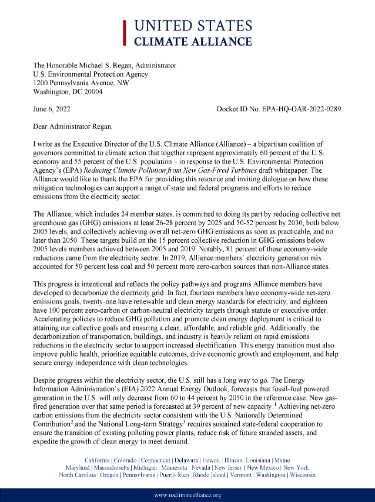Home / U.S. Climate Alliance Provides Input to EPA on Efforts to Reduce Climate Pollution from New Gas-Fired Turbines
- Letter
U.S. Climate Alliance Provides Input to EPA on Efforts to Reduce Climate Pollution from New Gas-Fired Turbines
June 6, 2022
The U.S. Climate Alliance would like to thank the U.S. Environmental Protection Agency (EPA) for publishing the Reducing Climate Pollution from New Gas-Fired Turbines draft whitepaper and inviting dialogue on how these mitigation technologies can support a range of state and federal programs and efforts to reduce emissions from the electricity sector.
The EPA has an obligation to regulate carbon dioxide as a GHG pollutant that endangers public health and welfare. While the whitepaper does not expressly establish policy, it describes a variety of control measures that could be successfully constructed and operated at gas-fired electric generating units to comply with state and federal programs. Alliance members support the issuance of federal regulations that provide long-term regulatory certainty for industry while establishing a stringent federal floor, rooted in the advances in emission control technologies. The nation needs holistic approaches to regulating carbon dioxide emissions including the development of a New Source Performance Standard for gas-fired electric generating units and regulations to further address emissions from existing power plants. Such regulations are critical to states’ ability to achieve their GHG targets, while supporting transitioning industries and protecting electricity customers.
The Alliance asks for continued engagement and partnership with states to ensure the country can achieve a decarbonization pathway consistent with the science and the cooperative federalism approach at the heart of the Clean Air Act. Whenever possible, we encourage flexible compliance pathways aligned with the implementation of existing enforceable state decarbonization policies. States would also benefit from the EPA’s technical assistance on evaluating costs and benefits associated with technologies in the whitepaper. EPA should seek to align implementation timelines for any new federal rules to streamline planning and compliance. Lastly, Alliance members support mitigation strategies that prioritize co-benefits, especially for those communities that are disproportionately impacted by local pollutants and other environmental factors.
About the Alliance
Launched on June 1, 2017 by the governors of Washington, New York, and California to help fill the void left by President Trump’s initial decision to withdraw the U.S. from the Paris Agreement, the Alliance has grown to include 24 governors from across the U.S. representing approximately 60% of the U.S. economy and 55% of the U.S. population. Governors in the Alliance have pledged to collectively reduce net greenhouse gas emissions by at least 26-28% by 2025, 50-52% by 2030, and 61-66% by 2035, all below 2005 levels, and collectively achieve overall net-zero greenhouse gas emissions as soon as practicable, and no later than 2050.
The Alliance’s states and territories will continue to advance innovative and impactful climate solutions to grow the economy, create jobs, and protect public health, and have a long record of action and results. In fact, the Alliance reduced its collective net greenhouse gas emissions by 19% between 2005 and 2022, while increasing collective GDP by 30%, and is on track to meet its near-term climate goal by reducing collective GHG emissions 26% below 2005 levels by 2025. The coalition’s states and territories are employing more workers in the clean energy sector, achieving lower levels of dangerous air pollutants, and preparing more effectively for climate impacts and executing more pre-disaster planning than the rest of the country.
###
